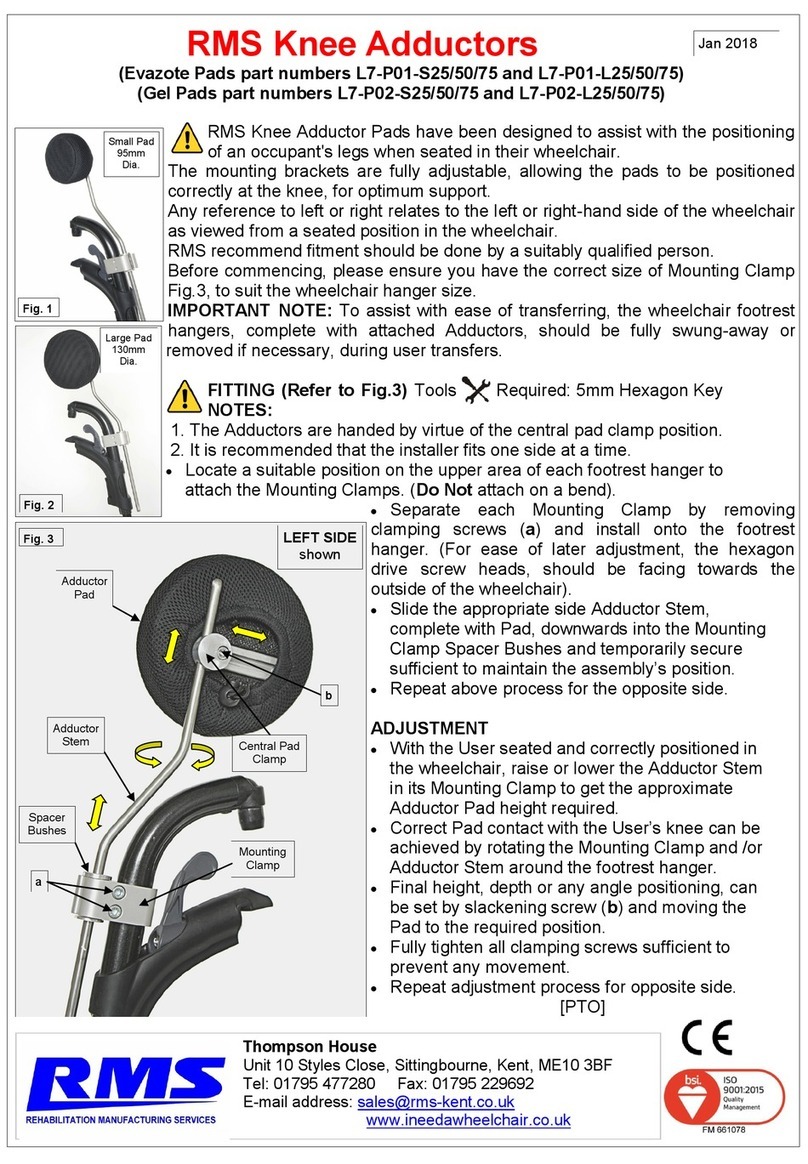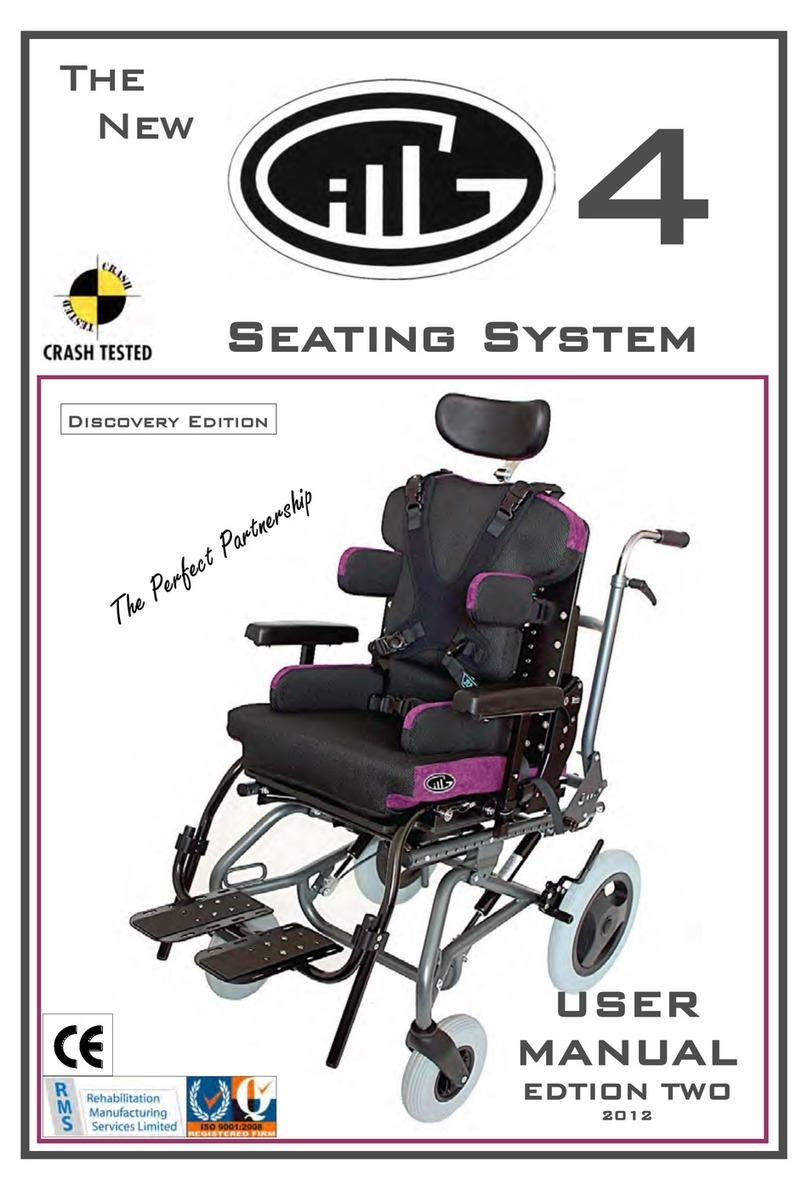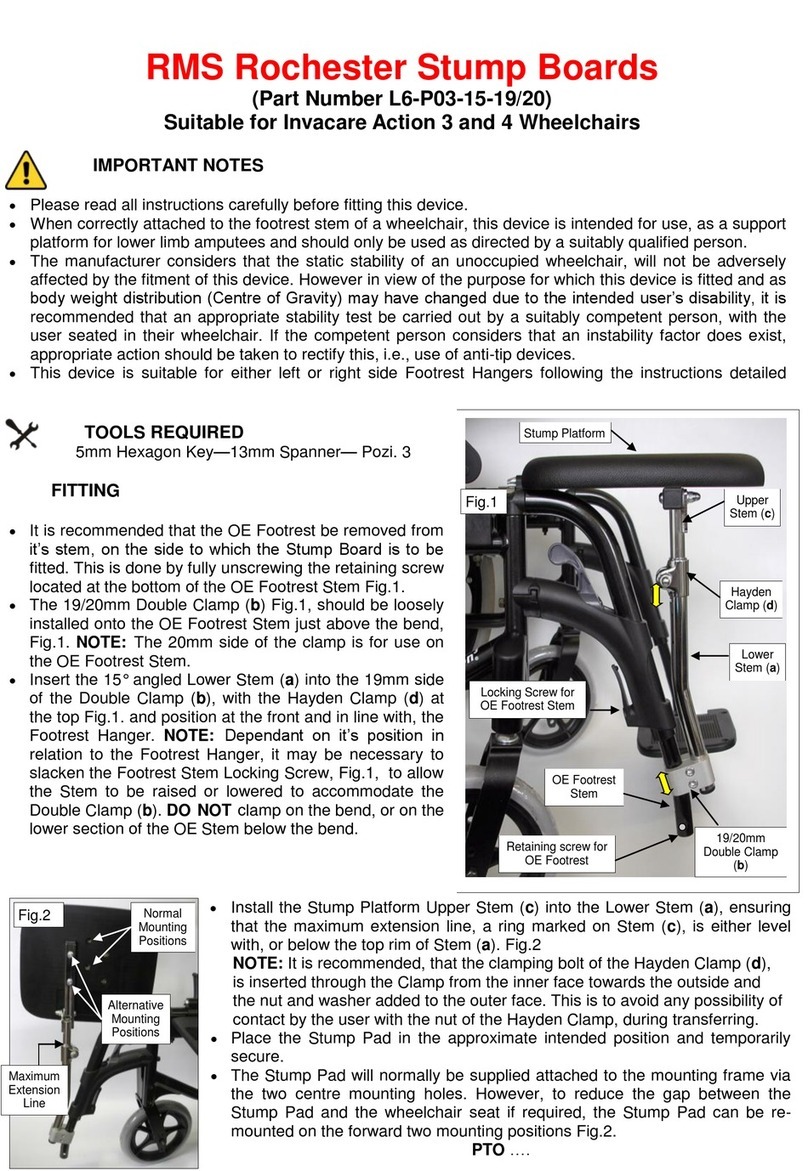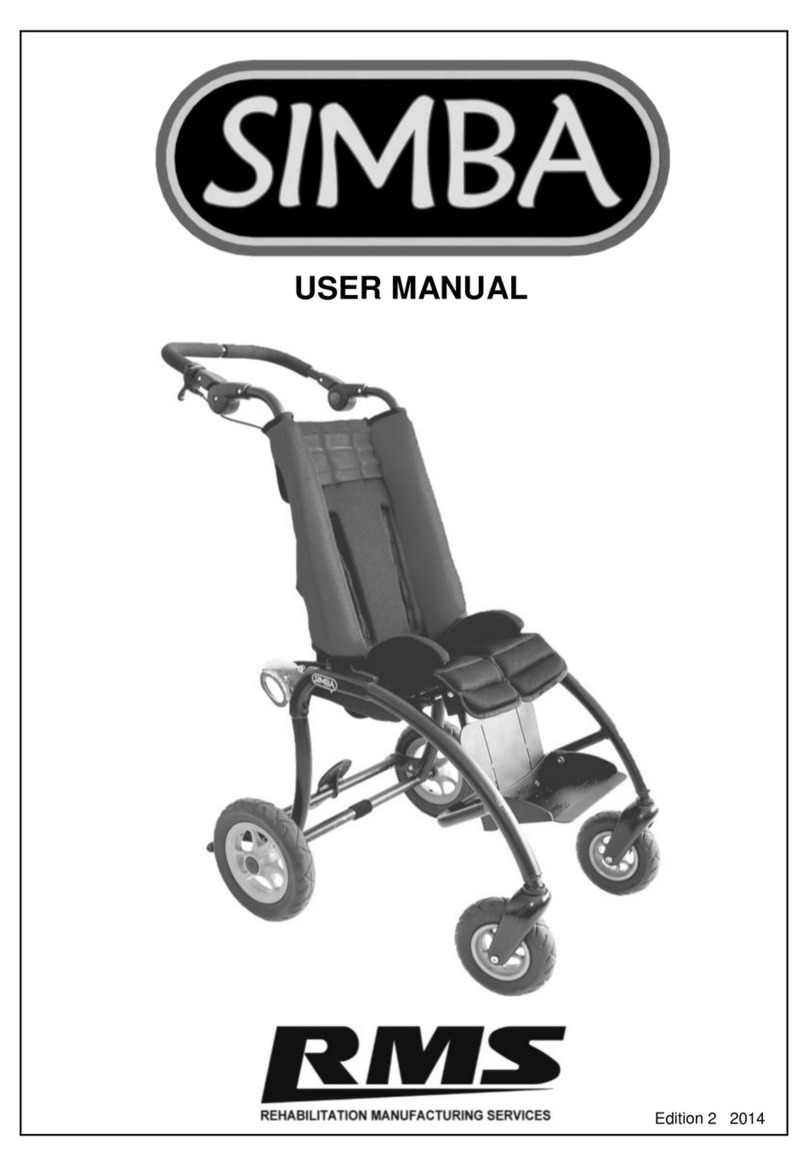RMS caddy User manual

Thompson House
Unit 10 Styles Close, Sittingbourne, Kent, ME10 3BF
Tel: 01795 477280 Fax: 01795 229692
E-mail address: sales@rms-kent.co.uk
www.ineedawheelchair.co.uk
The
Manufactured
by
Seating System
The
Seating System
Installation and User Manual
EDITION 3 May. 2017

INTRODUCTION
RMS Ltd would like to take this opportunity of thanking you for choosing a
caddy Seating System. We are confident that it will meet with the necessary
seating requirements of the user for which it was prescribed.
From the time of its initial conception, the caddy Seating System has undergone
rigorous strength testing and quality inspections, including successful “Crash
Testing” to ISO 16840-4 standard using a 50Kg ATD.
In view of the wide range of wheelchairs into which the caddy Seating System
can be interfaced, the pictures in this manual may not depict identically the
components supplied, or the location positions of installation for your specific
application. They are intended however, for general guidance purposes only and
to assist a suitably qualified person to install and adjust a complete caddy
Seating System.
RMS Ltd reserves the right to change, without notice, the design, methods of
manufacture, or any materials used in the construction of the caddy Seating
System, where it considers such changes will serve to improve the product
quality, or become necessary to meet any changes in device legislation.
Should the reader have any concerns regarding the installation, set-up,
adjustment, or use of the caddy Seating System, please contact the RMS Ltd.
Technical Help-Line on 01795-477280.
CONTENTS Page
Introduction 2
Safety Guidelines 3
Component Identification 4
Initial Installation:- 5
Seat and Backrest Identification (Positive Locking style) 6
Seat and Backrest Identification (Standard style) 7
Seat Base Installation (Using lock & Latch interfacing) 8
Installing Lock & Latch 8/9
Seat Base Installation (Fixed/Bolt-on Interface) 10/11
Backrest Installation (Positive Locking style) 12/13
Backrest Installation (Standard style) 13
Backrest Remove/Refitting and Angle Adjustment 14
Backrest Height Adjustment 15
Pelvic Supports 15 and 19
Lateral Thoracic Supports 16
Accessory Tricep Pads and Shoulder Pads 17
Accessory Headrest and Mounting 18
Alternative Pelvic Supports and Accessory Knee Adductors 19
Accessory Leg Abductor (Pommel) 20
Upholstery Care and Maintenance 21
Transportation 22-24
Warranty Statement 25
General Information, Product Maintenance and
Inspection Record 26
2
27
USER / CARER NOTES

26
GENERAL INFORMATION
Your caddy Seat Base serial Number is: …………………….........…
Your caddy Backrest serial number is: ……...…………..........……
Date of Supply: ………………..........………
Supplied to: …………………………………………………….....….…….
…………………………………………………….....………….
.………………………………………………………......………
PRODUCT MAINTENANCE
For safety reasons, the manufacturer recommends that components such as
the Seat Base Brackets, Lock and Latch Interface Brackets, Backrest
Mounting Brackets, Headrest Mountings, Pelvic Support Mountings, Thoracic
Support Mountings, Abductor and Adductor Mountings are checked for security at
annual intervals. Inspection frequency should be increased accordingly for heavy
users.
Any defects should be reported to the appropriate authority, with any repairs
being carried out using genuine original equipment replacement parts, available
direct from RMS Ltd.
(Also refer to Upholstery Maintenance section on pages 21).
INSPECTION RECORD
DATE INSPECTED
BY
COMMENTS SIGNED
3
SAFETY GUIDELINES
Due to the various activities that a wheelchair user has to perform, RMS
recommends that, prior to issuing the caddy Seating System and the
wheelchair into which it is to be interfaced, this manual, together with any
wheelchair manufacturer’ User Guide, should be studied by all relevant
persons to ensure that all instructions, procedures and warnings are
carefully observed and understood.
Prior to commencing the installation of a caddy Seating System, the
surrogate wheelbase should be placed on a level non-slip surface with the
parking brakes applied.
For correct support and user comfort, it is strongly recommended that the
initial installation and adjustments are carried out by a suitably qualified
person.
The maximum occupant capacity of a complete caddy Seating System for
transportation purposes, when interfaced into a suitably tested wheelchair
with a seat width up to 17", is 50Kg.
As the installation of a caddy Seating System may raise or position the user
further forward in their wheelchair, an appropriate stability test should be
carried out prior to final commissioning.
After the caddy Seating System has been initially adjusted to suit the
individual user, any settings should not be subsequently affected by the
removal and refitting of the Seat Base or Backrest to allow the wheelchair to
be folded. However, care should be taken not to impact adjustable
components whilst the Seat Base or Backrest is removed from the wheelchair
as this could affect their original pre-set position.
To accommodate any changes in user growth or postural positioning, it is
recommended that the user be checked at regular intervals by a suitably
qualified person, to ensure that adjustable components are correctly set to
suit the user’s current requirements.
Carers should ensure correct utilisation of any positioning Straps or
Harnesses, as failure to do so could result in injury to the user. It is
recommended that any postural Straps or Harnesses being used, are the first
items to be secured when the user enters the seat and the last items to be
released before exiting.
Worn or damaged upholstery can lead to hygiene contamination, cause
injury to the user and, in some cases, fail to support the user correctly.
Regular inspections of all upholstery should be made and any defects should
be reported to the relevant authority for rectification as soon as possible.
Ancillary devices, such as the Headrest, positioning Straps and Harnesses,
Knee-block or Pommel should be checked for security on a daily basis.
The wheelchair parking brakes should always be applied before attempting to
transfer the occupant, removing or refitting the caddy Seating System or
making any adjustments.
Never hang heavy objects on the caddy Seating System or any part of the
wheelchair, as this could seriously affect the overall stability.

The caddy Seating System —Component Identification
4
RMS positive-locking
“Swing-Away”
Lateral Supports
with removable,
washable Covers
Lock & Latch
Interfacing
System
Width Adjustable
Pelvic Supports
with removable,
washable Covers
Multi-adjustable
Headrest
with removable,
washable Cover
Padded Backrest
Cushion
with removable,
washable Cover
Optional
Flat or Ramped
Cushion
with removable,
washable Cover
Sacral Pad
with removable,
washable Cover
Seat Depth
Adjustment
Panel
Fig. 1
WARRANTY STATEMENT
Every effort is made by RMS Ltd to ensure that your caddy Modular
Adjustable Seating System is manufactured to the highest standards and
supplied to the specifications as detailed on the prescription.
The supply of our quality products is backed by the company’s ISO 9001
–2015 Quality Management System and CE Marking declaration.
The caddy Modular Seating System is supplied with a manufacturer’s
warranty covering faulty materials or workmanship, for a period of twelve
months from the date of dispatch from our factory.
In the unlikely event of a warranty claim being necessary, the failed part
must be returned to the manufacturer, or the manufacturer’s approved
repairer, for inspection. The failed part may then be repaired or replaced at
the manufacturer’s discretion or that of their approved repairer.
In the latter case, any displaced parts must be returned to the manufacturer
for inspection.
Any part, component or accessory, repaired or replaced during the twelve
month warranty period, will continue to be covered for the balance of the
warranty period only.
As unusually high rates of wear on this device, or its ancillary parts, may be
caused by the user’s clinical condition, the manufacturer may consider this
to be beyond its control. Therefore, items such as Upholstery may only be
considered for repair or replacement under the terms of the product
warranty where a failure is clearly attributed to a manufacturing, material or
fabric defect.
With the exception of modifications and /or alterations carried out by the
manufacturer, to meet the clinical needs of the user, any attempt to change
the design or modify the construction of the caddy Modular Seating
System in any way, will invalidate the product warranty and the
manufacturer’s CE marking declaration.
For further assistance with any matters relating to the product warranty or product Technical
Information, please contact the RMS Ltd Technical Help-line on 01795-477280.
25

Occupant Restraint Considerations:
A prescription should specify the type of occupant restraint required in a vehicle,
i.e. a lap and diagonal belt or full harness. The amount of upper body control that
the user has during normal vehicle movement should be taken into account.
“Normal” movement includes, braking and cornering, which have considerable
effect on persons with limited upper trunk control.
Some wheelchair users for example, may be able to maintain an upright posture
when using the wheelchair indoors, but not whilst travelling in a motor vehicle.
Such considerations apply equally to lower limb amputees and users in
supportive seating units who may also have limited upper body control.
**********
Example pictures from the successful caddy testing to ISO 16840-4
PRE-TEST
POST TEST
24
5
INITIAL INSTALLATION
IMPORTANT NOTES:
The caddy Seating System is supplied assembled and ready to be
interfaced onto the intended surrogate wheelchair. However, the installer
should note that some adjustment of both Seat and Backrest Support
Brackets may be necessary to ensure correct interfacing.
The installer should also note that at the time of despatch from the RMS
factory, none of the Backrest or Seat Base Support Brackets have been
fully and finally tightened. This has been done to allow the installer ease
of correctly positioning the interface brackets to suit the intended
surrogate base.
It is therefore, the responsibility of the installer to ensure that all
Interface Mounting and Component Screws and Nuts are correctly
tightened, before handover to the user. (This does not apply to caddy
Seating Systems interfaced with a surrogate base at the RMS factory).
Where the caddy Seating System is supplied by RMS Ltd., together with a
surrogate wheelbase, the following installation instructions may not
apply, as the interfacing and mounting brackets will normally be pre-set at
the RMS factory prior to delivery. Adjustable components may also be pre
-set to the required specification, where the necessary information was
stated on the device prescription.
Before commencing installation, the surrogate wheelchair should be
vacated and placed on a suitable level non-slip surface, with the parking
brakes applied.
For ease of installation, both side-arms should be removed wherever
possible.
Any references to left or right, relate to positions as viewed from being
seated in the wheelchair facing forwards.
The basic weight of a “Standard Specification” caddy Seating System to
suit a 43cm (17”) seat width wheelchair is 11.5Kg (25.3lbs)
Table of contents
Other RMS Wheelchair manuals























